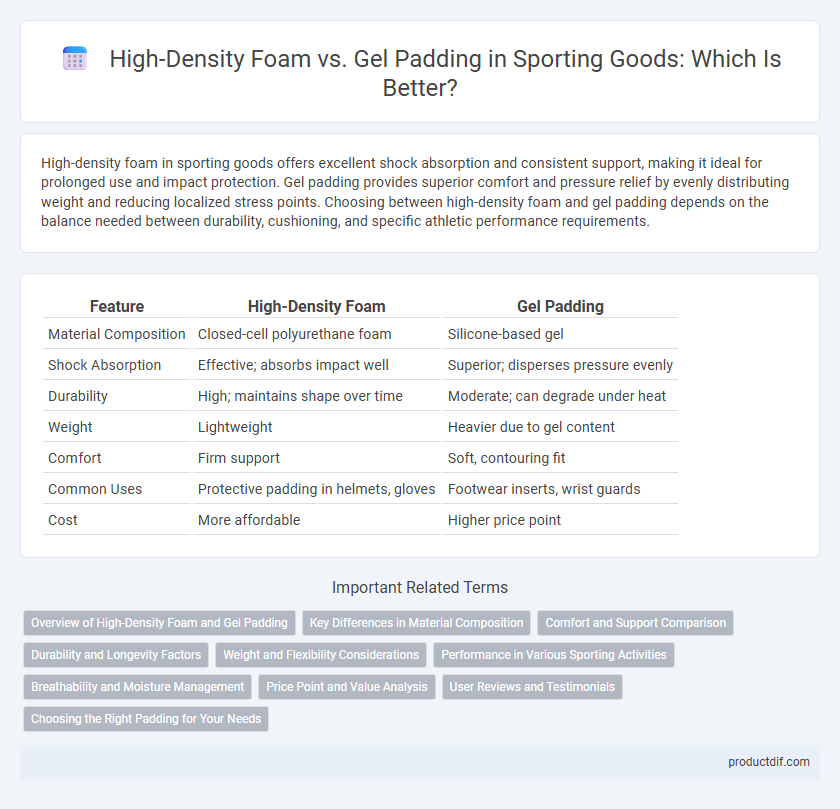High-density foam in sporting goods offers excellent shock absorption and consistent support, making it ideal for prolonged use and impact protection. Gel padding provides superior comfort and pressure relief by evenly distributing weight and reducing localized stress points. Choosing between high-density foam and gel padding depends on the balance needed between durability, cushioning, and specific athletic performance requirements.
Table of Comparison
| Feature | High-Density Foam | Gel Padding |
|---|---|---|
| Material Composition | Closed-cell polyurethane foam | Silicone-based gel |
| Shock Absorption | Effective; absorbs impact well | Superior; disperses pressure evenly |
| Durability | High; maintains shape over time | Moderate; can degrade under heat |
| Weight | Lightweight | Heavier due to gel content |
| Comfort | Firm support | Soft, contouring fit |
| Common Uses | Protective padding in helmets, gloves | Footwear inserts, wrist guards |
| Cost | More affordable | Higher price point |
Overview of High-Density Foam and Gel Padding
High-density foam provides firm support and excellent shock absorption, making it ideal for sustained impact in sports like football and hockey. Gel padding offers superior flexibility and conforms to the body, enhancing comfort and reducing pressure points during prolonged use in activities such as cycling and running. Both materials improve protection, but the choice depends on the required balance between rigidity and adaptability for specific sporting needs.
Key Differences in Material Composition
High-density foam in sporting goods offers firm support and excellent shock absorption due to its dense cellular structure, providing enhanced durability and consistent cushioning. Gel padding, composed of viscoelastic materials, delivers superior impact dispersion and conforms to the athlete's body shape for personalized comfort and pressure relief. The primary difference lies in high-density foam's rigidity and longevity compared to gel padding's flexibility and adaptive cushioning properties.
Comfort and Support Comparison
High-density foam provides consistent support and cushioning by evenly distributing pressure, making it ideal for prolonged use in sporting goods like insoles and protective gear. Gel padding offers superior shock absorption and adapts to body contours, enhancing comfort during high-impact activities. Choosing between high-density foam and gel depends on the specific sport's demands for either firm support or dynamic cushioning.
Durability and Longevity Factors
High-density foam offers superior durability due to its rigid cellular structure, allowing it to retain shape and cushioning over prolonged use in sporting goods such as protective gear and footwear. Gel padding, while providing enhanced shock absorption and comfort, tends to compress and degrade faster under repetitive impact, potentially reducing its lifespan. Choosing high-density foam enhances longevity for athletes requiring consistent protection and support during intense physical activities.
Weight and Flexibility Considerations
High-density foam typically offers greater lightweight properties compared to gel padding, making it ideal for sporting goods where minimizing weight is essential. This type of foam also provides consistent flexibility, allowing for enhanced movement and comfort during physical activities. Gel padding, while excellent for shock absorption, tends to be heavier and less flexible, potentially restricting performance in dynamic sports scenarios.
Performance in Various Sporting Activities
High-density foam offers superior shock absorption and stability, making it ideal for high-impact sports like football and hockey where protection and durability are crucial. Gel padding excels in providing enhanced comfort and pressure distribution, benefiting endurance activities such as running and cycling where prolonged cushioning reduces muscle fatigue. Selecting the appropriate padding material directly influences athletic performance by balancing support, energy return, and injury prevention tailored to specific sports demands.
Breathability and Moisture Management
High-density foam offers moderate breathability but tends to retain more heat and moisture during intense activities, which can lead to discomfort and sweat buildup. Gel padding provides superior moisture management by allowing better airflow and distributing pressure evenly, reducing hotspots and enhancing overall comfort. Athletes seeking optimal breathability and sweat control often prefer gel padding for extended wear in high-performance sporting gear.
Price Point and Value Analysis
High-density foam padding offers a budget-friendly option with durable shock absorption, making it ideal for athletes seeking cost-effective protection. Gel padding typically comes at a higher price point but provides superior contouring and enhanced comfort, which can improve overall performance by reducing pressure points. Evaluating value depends on balancing the lower upfront cost of high-density foam against the long-term benefits and ergonomic support provided by gel padding.
User Reviews and Testimonials
High-density foam padding consistently receives praise in user reviews for its excellent shock absorption and durability during intense sporting activities. Gel padding testimonials highlight superior comfort and pressure relief, particularly appreciated by athletes with sensitive areas or joint concerns. Combining both materials often emerges in reviews as an optimal solution, offering enhanced protection and all-day comfort for diverse sports enthusiasts.
Choosing the Right Padding for Your Needs
High-density foam offers excellent shock absorption and durability, making it ideal for sustained impact activities like running or cycling. Gel padding provides superior comfort and pressure distribution, which benefits sports requiring prolonged contact or repetitive motions, such as weightlifting or tennis. Evaluating the intensity and type of your sport helps in selecting the most effective padding that enhances performance and prevents injury.
High-Density Foam vs Gel Padding Infographic

 productdif.com
productdif.com